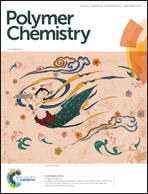A detailed mechanistic study of bulk MADIX of styrene and its chain extension†
Abstract
The microstructural evolution of individual macrospecies during bulk macromolecular design by interchange of xanthates (MADIX) of styrene with (O-ethyl xanthate)-2-ethyl propionate as an initial agent (R0X) and its chain extension with fresh styrene or n-butyl acrylate (nBuA) is visualized in silico, allowing an unbiased (co)polymer product quality labelling according to monomer sequences and end-groups. Degenerative transfer coefficients for both exchange with R0X (Ctr,0) and macro-RAFT agent (Ctr) are reported (Ctr,0 = 0.80 ± 0.02; Ctr: 0.44 ± 0.07) by applying multi-response regression analysis to the experimental data on the RAFT agent and styrene conversion, number and mass average molar masses, and end-group functionality (EGF). The EGF data are obtained by combining dialysis to remove residual R0X species and elemental analysis. It is shown that the MADIX mechanism can be properly understood only by explicitly acknowledging the differences in exchange reactivities and that the macroradical homopolymer CLD follows a Flory–Schulz distribution, which is an exception for controlled reversible addition–fragmentation chain transfer polymerization. Moreover, for the selected monomer conversion ranges, both “blocks” of the chain extension are formed through a single exchange.



 Please wait while we load your content...
Please wait while we load your content...